Sound is the pressure changes that occur in a specific
environment and are detected by our ears.
When a vibrating object leaves its static equilibrium, it pushes and compresses the air in front of it. Simultaneously, a sudden pressure decrease occurs behind the vibrating object, and the air rapidly fills the gap created behind. These pressure changes are transmitted to distant points, and the air enters the motion known as sound waves.
Sound is the pressure changes that occur in a specific environment and are detected by This pressure change can be perceived as sound by the human ear only if it vibrates at least 20 times per second. The number of pressure changes per second is expressed as the frequency of sound and is measured in Hertz (Hz).
The frequency of sound determines the distinctive tone of a sound. Normally, a human ear can hear sounds vibrating between 20 Hz and 20,000 Hz. These pressure changes travel from the sound source to the listener's ear in an elastic medium such as air.
The wavelength of sound is expressed as the speed of sound/frequency. This means that; High-frequency sounds have short wavelengths, while low-frequency sounds have long wavelengths. Therefore, sound can have many different frequencies.
When a vibrating object leaves its static equilibrium, it pushes and compresses the air in front of it. Simultaneously, a sudden pressure decrease occurs behind the vibrating object, and the air rapidly fills the gap created behind. These pressure changes are transmitted to distant points, and the air enters the motion known as sound waves.
Sound is the pressure changes that occur in a specific environment and are detected by This pressure change can be perceived as sound by the human ear only if it vibrates at least 20 times per second. The number of pressure changes per second is expressed as the frequency of sound and is measured in Hertz (Hz).
The frequency of sound determines the distinctive tone of a sound. Normally, a human ear can hear sounds vibrating between 20 Hz and 20,000 Hz. These pressure changes travel from the sound source to the listener's ear in an elastic medium such as air.
The wavelength of sound is expressed as the speed of sound/frequency. This means that; High-frequency sounds have short wavelengths, while low-frequency sounds have long wavelengths. Therefore, sound can have many different frequencies.
Sounds fade away after a certain period of time, so it
becomes impossible to hear them after a while.
However, sounds don't disappear in terms of the energy they carry. This is because the resulting sound waves, due to their propagation by compressing and expanding the air, carry some energy with them.
As sound waves propagate, some of the energy they carry separates from the wave, causing the environment to warm up.
As sound waves propagate, their amplitude/loudness decreases as they move further from the source. In other words, they gradually become weaker. Due to the decrease in amplitude and the resulting frictional losses, they gradually become unnoticeable due to the compression and expansion caused by the molecules in the medium. Therefore, no signal remains in the environment that we can perceive as sound.
Wind and air temperature should also be taken into account when interpreting sound waves.
If the wind is blowing from behind, the direction of the sound is toward the ground. Conversely, if the wind is blowing from the front, the direction of the sound is from the ground up.
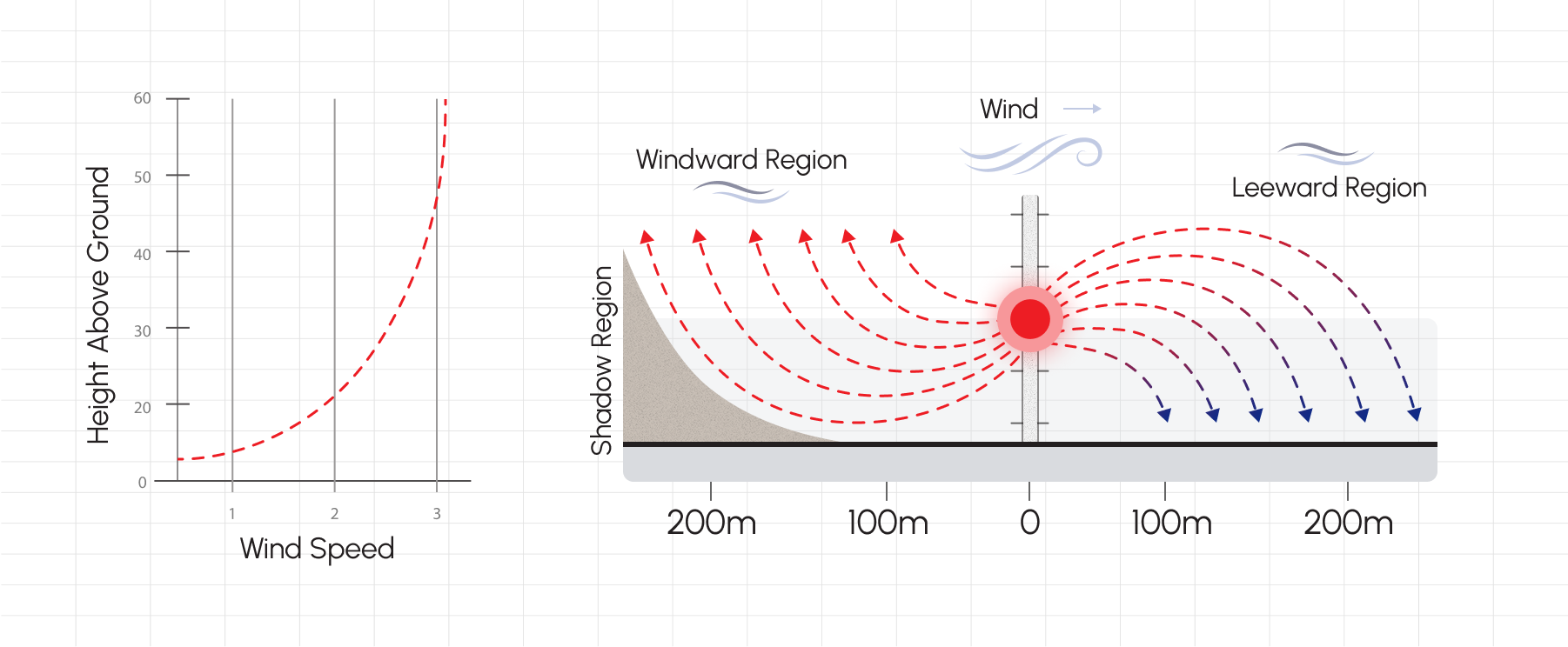 Air temperature also affects sound waves. For example, during the day, sound waves
travel upward as the ground warms, while at night, sound waves travel farther and
travel downward as the ground cools.
Air temperature also affects sound waves. For example, during the day, sound waves
travel upward as the ground warms, while at night, sound waves travel farther and
travel downward as the ground cools.
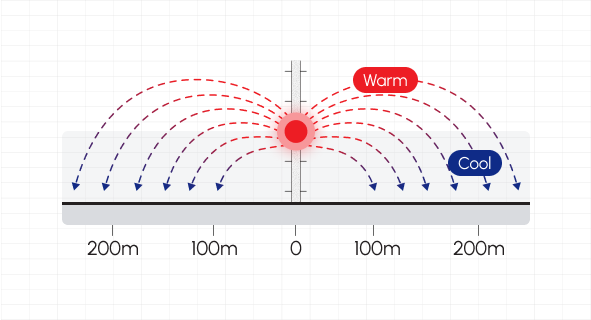
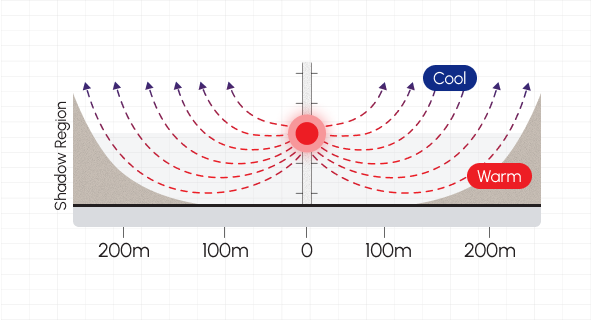 Sound waves are divided into 4;
Sound waves are divided into 4;
However, sounds don't disappear in terms of the energy they carry. This is because the resulting sound waves, due to their propagation by compressing and expanding the air, carry some energy with them.
As sound waves propagate, some of the energy they carry separates from the wave, causing the environment to warm up.
As sound waves propagate, their amplitude/loudness decreases as they move further from the source. In other words, they gradually become weaker. Due to the decrease in amplitude and the resulting frictional losses, they gradually become unnoticeable due to the compression and expansion caused by the molecules in the medium. Therefore, no signal remains in the environment that we can perceive as sound.
Wind and air temperature should also be taken into account when interpreting sound waves.
If the wind is blowing from behind, the direction of the sound is toward the ground. Conversely, if the wind is blowing from the front, the direction of the sound is from the ground up.



- Infrasound: Sound waves of 20-30 hertz and below.
- Audible sound: Sound waves between 20-20,000 hertz.
- Ultrasound:Sound waves from 20 kHz to 15 MHz.
- Hypersound:Sound waves with frequencies above 15 MHz.
The frequency of a wave is how often it causes particles in
the medium to vibrate as it passes through air or another medium.
Frequency is expressed in Hertz (1 Hertz = 1 cycle/second).
Frequency is expressed in Hertz (1 Hertz = 1 cycle/second).
Another quantity used to describe sound is the amplitude of
the resulting pressure change.
Amplitude is the vertical magnitude of sound waves.
The difference between the compression and expansion that create sound waves determines their amplitude.
The greater the energy driving the vibration, the greater the amplitude. The greater the amplitude, the more energy is carried by the air molecules. The greater the energy, the greater the intensity of the sound.
Amplitude is the vertical magnitude of sound waves.
The difference between the compression and expansion that create sound waves determines their amplitude.
The greater the energy driving the vibration, the greater the amplitude. The greater the amplitude, the more energy is carried by the air molecules. The greater the energy, the greater the intensity of the sound.
The distance between two consecutive crests or troughs of a
wave gives us the wavelength.
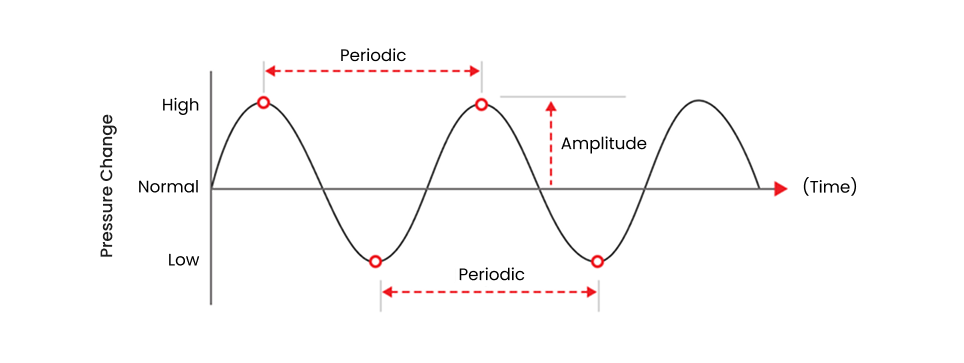 How to Calculate:
How to Calculate:
- Amplitude: pressure change (dB)
- Frequency: number of cycles per second (Hz)
- Period: duration of one cycle (T)
- Velocity: in one directions
- Wavelength (λ): length of one cycle in space; λ = speed / frequency (m)
- Phase: time characteristic of the wave; state of the cycle at a certain time

- Amplitude: pressure change (dB)
- Frequency: number of cycles per second (Hz)
- Period: duration of one cycle (T)
- Velocity: in one directions
- Wavelength (λ): length of one cycle in space; λ = speed / frequency (m)
- Phase: time characteristic of the wave; state of the cycle at a certain time
The lowest sound intensity that the human ear can perceive
is known as the ‘threshold intensity’. The intensity of the loudest sound that can
be heard without damaging the ear is approximately 1 million times the threshold
intensity.
Hearing Threshold; The rms value of the smallest pressure fluctuation that the human ear can detect: 20μPa
Hearing range: 20 Hz-20000 Hz, 20μPa-200Pa
Since the intensity perception range of the human ear is so wide, the scale used for measuring intensity is called ‘decibel’.
Sound Power (Watt): It is the total sound energy emitted by the sound source per unit of time. It is the measure of how much sound energy the sound source produces, independent of environmental factors.
Hearing Threshold; The rms value of the smallest pressure fluctuation that the human ear can detect: 20μPa
Hearing range: 20 Hz-20000 Hz, 20μPa-200Pa
Since the intensity perception range of the human ear is so wide, the scale used for measuring intensity is called ‘decibel’.
Sound Power (Watt): It is the total sound energy emitted by the sound source per unit of time. It is the measure of how much sound energy the sound source produces, independent of environmental factors.
A healthy human ear can hear sounds between 20 Hz and 20
kHz.
While a 6 dB increase in volume corresponds to a doubling of sound pressure, the decibel increase equivalent to a doubling of loudness is 10 dB. The smallest change in sound we can detect is 3 dB.
Another important factor is that the human ear is not equally sensitive to sounds of different frequencies. While the human ear is more sensitive to sounds between 2 kHz and 5 kHz, it is less sensitive to higher and lower frequencies. This sensitivity of the human ear to different frequencies is greater at low sound pressure levels than at high sound pressure levels.
While a 6 dB increase in volume corresponds to a doubling of sound pressure, the decibel increase equivalent to a doubling of loudness is 10 dB. The smallest change in sound we can detect is 3 dB.
Another important factor is that the human ear is not equally sensitive to sounds of different frequencies. While the human ear is more sensitive to sounds between 2 kHz and 5 kHz, it is less sensitive to higher and lower frequencies. This sensitivity of the human ear to different frequencies is greater at low sound pressure levels than at high sound pressure levels.
- - The speed of sound propagation in air is directly proportional to the temperature of the air.
- - The rate of spread is higher at higher air temperatures.
- - In acoustic calculations, the speed of sound propagation in air at 20°C, 340 m/s, is generally used.
- - It depends on the density and flexibility of the medium. Sound travels faster in solid media.
- - It depends on whether the medium is solid, liquid or gas.
- - The amount of humidity in the environment affects the speed of sound.
- - mmIn air; 340 m/s
- - In water; 1,400 m/s
- - In steel; 5,000 m/s
- • Decibel (dB): Sound pressure level is measured in decibels. 0 dB SPL is taken as the hearing threshold.
- • Sound pressure is the deviation of a sound wave from the local ambient pressure level. The unit of sound pressure is Pascal (symbol: Pa). Calibration is generally performed so that 1 Pascal equals 94 dB SPL.
- • Sound intensity is the acoustic or sound power per unit area (W). The unit of sound intensity is W/m2.
- dB scale: increases and decreases logarithmically.
- • A 40 dB noise is subjectively perceived as half of a 50 dB sound.
-
• 20 dB is 10 times more intense than 10 dB.
• 30 dB is 100 times more intense than 10 dB. - • The human ear can respond to sound over an incredibly wide range. A sound at the upper limit, that is, at the painful limit, is ten million times larger than the quietest sound that can be heard.
- • Another feature of the decibel property is that the sound pressure levels of two different sounds are not added arithmetically. For example, if a 60 dB sound is added to another 60 dB sound, the increase will be only 3 dB; that is, the total will be 63 dB, not 120 dB. Furthermore, if two sounds have different levels, the contribution of the lower one to the higher one decreases as the difference decreases.
- • If the level difference between the two is more than 10 dB, the low level sound has no effect.
- • It is generally accepted that sound above 85 dB will be harmful to the ear.
Absorption: The absorption of sound energy by a material and
its conversion into heat.
Absorption characteristics depend on frequency, thickness, back air space, and density.
Absorption characteristics depend on frequency, thickness, back air space, and density.
The Doppler effect is the frequency shift experienced when
the sound source and the observer are moving. The sound frequency increases as the
vehicle approaches and decreases as it recedes. It was first described by Christian
Doppler in 1842.
High-intensity sound damages the auditory nerves in the
inner ear. The louder the sound, the greater the risk of damage. Ear damage is
related to the duration of exposure as well as the intensity of the sound. Noise
primarily reduces the ability to hear high-frequency sounds (high-pitched tones).
Prolonged exposure to noise also affects the ability to hear lower-frequency sounds.
Short-term exposure to noise can cause temporary and mild hearing loss. However,
prolonged and repetitive noise often causes permanent hearing loss. Exposure to 90
dB noise for more than 8 hours per day, 100 dB noise for 2 hours per day, and 115 dB
noise for more than 15 minutes per day can cause permanent damage.
Sound propagation in air is similar to the propagation of
waves in water. Waves propagate in each direction with decreasing amplitude as they
move away from the wave source. Sound propagation in air occurs as follows: when a
sound wave is doubled in distance from the source, its amplitude decreases by a
factor of 2. For example, if you are 1 meter away from a source and move 1 meter
further away, the sound pressure level decreases by 6 dB. If you move 4 meters
further away, the sound pressure level decreases by 12 dB. If you move 8 meters
further away, the sound pressure level decreases by 18 dB, and so on. If there is an
obstacle in the sound propagation path, some of the sound waves are reflected when
they hit the obstacle, some are absorbed by the object, and the rest continue on
their path through the object. In principle, an object's ability to influence sound
waves depends on its dimensions being larger than the wavelength of the sound.
YAbsorption: When a sound wave strikes a surface, part of
the sound is reflected. The rest is absorbed by the material. Sound energy is
converted into another form, usually heat.
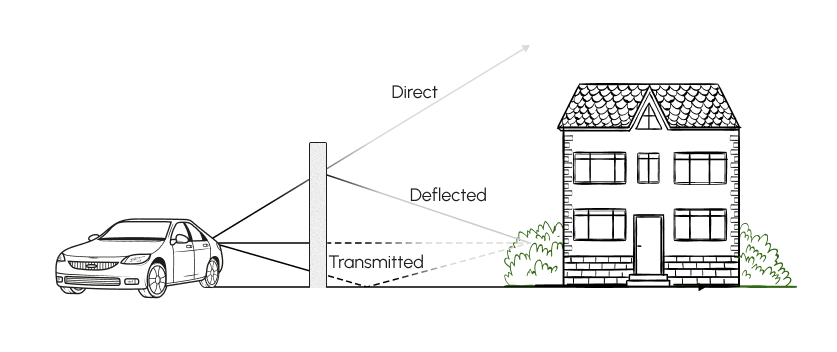 Sound absorption: The ability of a material to reduce (absorb) sound energy and
transmit it to other surfaces (e.g., subflooring).
Sound absorption: The ability of a material to reduce (absorb) sound energy and
transmit it to other surfaces (e.g., subflooring).
The sound absorption ability of a material depends on the following parameters:

The sound absorption ability of a material depends on the following parameters:
- • Frequency
- • Thickness
- • Presence of air behind it
- • Intensity
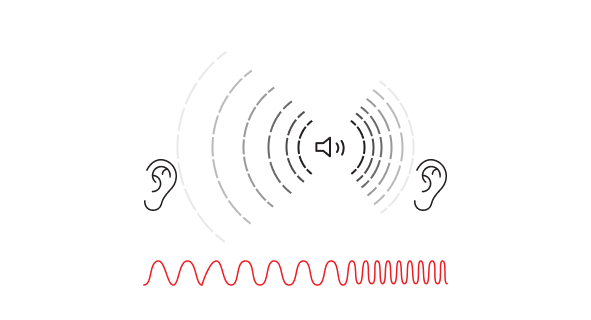
We can observe the Doppler effect in many situations in our daily lives. For example, while waiting on the sidewalk, we hear the engine sounds of vehicles approaching us gradually increase in frequency. As the vehicle begins to move away from us, the frequency gradually decreases. Or, it can be the change in tone of a vehicle honking as it approaches or moves away from the observer.
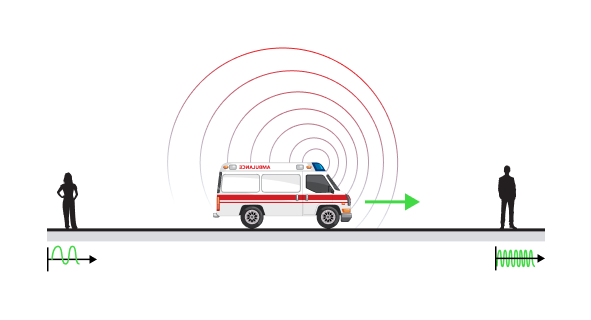
Conversely, if the wave is emitted from a farther location, the arrival time between successive waves will increase. At this point, the frequency of the observed wave will be less than the frequency of the wave emanating from the source.
The Doppler effect is named after its discovery in 1842 by Australian physicist Christian Doppler.
